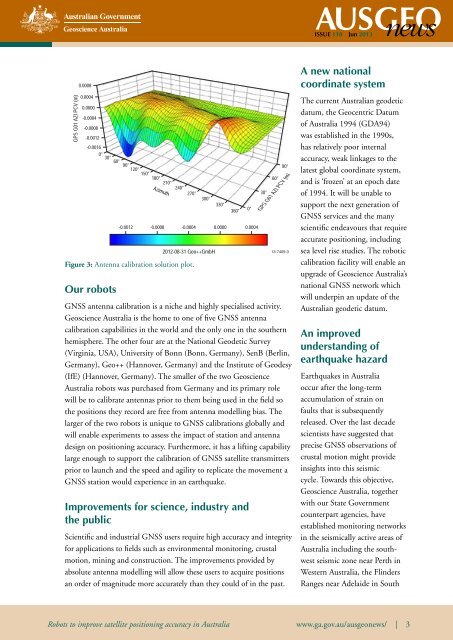Robots to improve satellite positioning accuracy in Australia
Robots to improve satellite positioning accuracy in Australia
Robots to improve satellite positioning accuracy in Australia
Create successful ePaper yourself
Turn your PDF publications into a flip-book with our unique Google optimized e-Paper software.
AUSGEO NEWS ISSUE 110 Jun 2013Figure 3: Antenna calibration solution plot.Our robotsGNSS antenna calibration is a niche and highly specialised activity.Geoscience <strong>Australia</strong> is the home <strong>to</strong> one of five GNSS antennacalibration capabilities <strong>in</strong> the world and the only one <strong>in</strong> the southernhemisphere. The other four are at the National Geodetic Survey(Virg<strong>in</strong>ia, USA), University of Bonn (Bonn, Germany), SenB (Berl<strong>in</strong>,Germany), Geo++ (Hannover, Germany) and the Institute of Geodesy(IfE) (Hannover, Germany). The smaller of the two Geoscience<strong>Australia</strong> robots was purchased from Germany and its primary rolewill be <strong>to</strong> calibrate antennas prior <strong>to</strong> them be<strong>in</strong>g used <strong>in</strong> the field sothe positions they record are free from antenna modell<strong>in</strong>g bias. Thelarger of the two robots is unique <strong>to</strong> GNSS calibrations globally andwill enable experiments <strong>to</strong> assess the impact of station and antennadesign on <strong>position<strong>in</strong>g</strong> <strong>accuracy</strong>. Furthermore, it has a lift<strong>in</strong>g capabilitylarge enough <strong>to</strong> support the calibration of GNSS <strong>satellite</strong> transmittersprior <strong>to</strong> launch and the speed and agility <strong>to</strong> replicate the movement aGNSS station would experience <strong>in</strong> an earthquake.Improvements for science, <strong>in</strong>dustry andthe publicScientific and <strong>in</strong>dustrial GNSS users require high <strong>accuracy</strong> and <strong>in</strong>tegrityfor applications <strong>to</strong> fields such as environmental moni<strong>to</strong>r<strong>in</strong>g, crustalmotion, m<strong>in</strong><strong>in</strong>g and construction. The <strong>improve</strong>ments provided byabsolute antenna modell<strong>in</strong>g will allow these users <strong>to</strong> acquire positionsan order of magnitude more accurately than they could of <strong>in</strong> the past.A new nationalcoord<strong>in</strong>ate systemThe current <strong>Australia</strong>n geodeticdatum, the Geocentric Datumof <strong>Australia</strong> 1994 (GDA94)was established <strong>in</strong> the 1990s,has relatively poor <strong>in</strong>ternal<strong>accuracy</strong>, weak l<strong>in</strong>kages <strong>to</strong> thelatest global coord<strong>in</strong>ate system,and is ‘frozen’ at an epoch dateof 1994. It will be unable <strong>to</strong>support the next generation ofGNSS services and the manyscientific endeavours that requireaccurate <strong>position<strong>in</strong>g</strong>, <strong>in</strong>clud<strong>in</strong>gsea level rise studies. The roboticcalibration facility will enable anupgrade of Geoscience <strong>Australia</strong>’snational GNSS network whichwill underp<strong>in</strong> an update of the<strong>Australia</strong>n geodetic datum.An <strong>improve</strong>dunderstand<strong>in</strong>g ofearthquake hazardEarthquakes <strong>in</strong> <strong>Australia</strong>occur after the long-termaccumulation of stra<strong>in</strong> onfaults that is subsequentlyreleased. Over the last decadescientists have suggested thatprecise GNSS observations ofcrustal motion might provide<strong>in</strong>sights <strong>in</strong><strong>to</strong> this seismiccycle. Towards this objective,Geoscience <strong>Australia</strong>, <strong>to</strong>getherwith our State Governmentcounterpart agencies, haveestablished moni<strong>to</strong>r<strong>in</strong>g networks<strong>in</strong> the seismically active areas of<strong>Australia</strong> <strong>in</strong>clud<strong>in</strong>g the southwestseismic zone near Perth <strong>in</strong>Western <strong>Australia</strong>, the Fl<strong>in</strong>dersRanges near Adelaide <strong>in</strong> South<strong>Robots</strong> <strong>to</strong> <strong>improve</strong> <strong>satellite</strong> <strong>position<strong>in</strong>g</strong> <strong>accuracy</strong> <strong>in</strong> <strong>Australia</strong> www.ga.gov.au/ausgeonews/ | 3
















